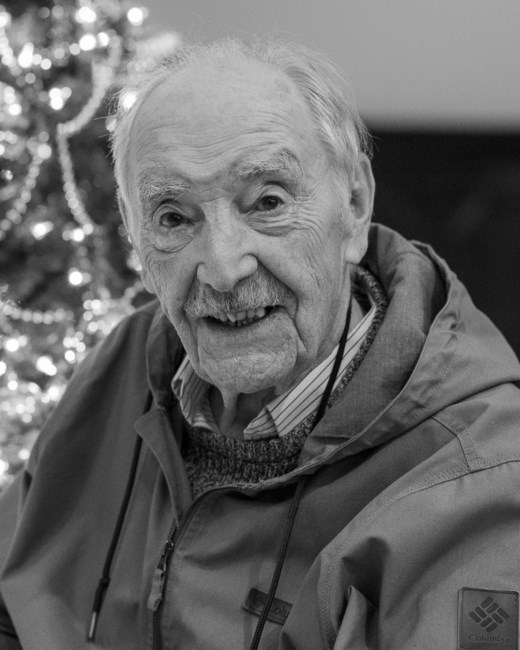
OBITUARIO
Robert Sinclair Rodger
26 junio, 1926 – 8 enero, 2021

Dr Robert “Bob” Sinclair Rodger was born Leo S.E. Jack Swann in Glasgow Scotland on June 26, 1926. He was adopted by Jane and Robert Rodger and raised in Fife, Scotland. His adopted dad was a coal miner but was blinded in an explosion and thus disabled and impoverished. He left school after ninth grade to become a blacksmith to help support the family. World War II was underway so he joined the Black Watch (The Royal Highland Regiment) as commissioned officer, Lieutenant Rodger in 1944 where he served in the UK, Africa and Germany. He gained military Law experience, self taught, acting as a defense officer in 3 Court Marshalls and then commanding a POW/Demobilization Camp in Germany at the end of the war. On returning to Scotland he furthered his education, entered the University of Edinburgh where he received his master’s degree. He married Margaret Beaton at Greyfriars Kirk in Edinburgh on 20 June 1953.
Little did he know at that time that below his feet in Greyfriars Kirk was buried James Lockhart, the son of his sixth great-grandfather, Sir John Lockhart, Lord Castlehill – a Justice of Scotland’s Supreme Court. Sir John’s brother Sir William Lockhart was married to Oliver Cromwell’s niece and later became deputy chief of Scotland’s Supreme Court.
After completing his master’s degree he took a junior academic post at Queens University of Belfast where he received his PhD in Psychology. There in Belfast, Northern Island he wrote his first textbook ”Statistical Reasoning in Psychology” and welcomed the birth of his son Robert Mark and daughter Susan Margaret. Shortly after, in 1963, he accepted a position as senior lecturer at the University of Sydney in Australia and sailed with his family half way around the world. In Sydney he published papers and taught psychology; wrote his second textbook “Intermediate Statistics” and formulated a new statistical analysis procedure known as the “Rodger’s method”. Bob was the 1966 recipient of the John Smyth Memorial Medal from Melbourne University, recognizing his contribution to education. He moved to Nova Scotia to accept a sabbatical position at Dalhousie University as a Killam Senior Fellow at the end of 1968 and eventually stayed on to become a full tenured professor and chairman of the Psychology Department. He continued to teach, write and mentor graduate students and was instrumental in creating and negotiating the first Dalhousie Faculty Association collective agreement in 1978 and served as DFA President 1978-79. This helped protect and negotiate salaries for over 1000 academics across most of the faculties of Dalhousie University and has protected the rights of academic staff for over 40 years. The DFA introduced the Dr. Robert S. Rodger Lecture Series in 2018 during their 40th anniversary to mark outstanding achievements in the promotion of collective bargaining and academic rights. He retired from the University in July 1991 but went on to work for the Nova Scotia Department of Fisheries as a statistician.
As an adopted child he was curious about his genealogy and researched it extensively after retirement. He would love you to know some of his family history that fascinated him so.
Over 100 baronets of Nova Scotia were created between 28 May 1625 and 30 April 1707. His first Baronet relative was Sir John Sinclair of Stevenson and he was created a baronet on 18 June 1636. A part of the esplanade of Edinburgh Castle was declared to be Nova Scotia territory, and that's where they were inducted into their rank. When he joined the army in 1944 he was stationed at Fort George in Inverness Scotland and worshipped in the chapel over the bones of his ancestor Sir Robert Sinclair Lieutenant Governor of Fort George and 7th baronet of Nova Scotia. His great granduncle Major General Sir Graeme Alexander Sinclair Lockhart the 10th baronet of Nova Scotia commanded the 78th Highlanders (The Ross-shire Buff) when they relieved the Residency at Lucknow during the Indian Mutiny in 1857. Eight Victoria Crosses (UKs highest award for valour) were awarded for that action, including one to the regiment as a whole and he received the Companion of the Bath medal from Queen Victoria. This medal and others, as well as a little red shell jacket he wore in the regiment are displayed in the Fort George museum. The 78th Highlanders were stationed at Citadel Hill in Halifax in 1869-71 but this was after Sir Graeme had retired. A reenactment of 78th Highlanders occurs on Citadel Hill to this day. Note that the motto "Corda Serato Fero" meaning "I bear a locked heart" is on the family coat of arms and derives from an ancestor (Sir Simon Lockhart) who carried the key to the small silver casket in which was the heart of Scotland's greatest king, Robert the Bruce, being carried to be buried in the Holy Land in 1329.
Even after retirement Bob continued to work on manuscripts and papers; refining his statistical method. He also created Wikipedia and Wikiversity pages in the hopes of promoting his statistical method into the future. https://en.wikiversity.org/wiki/Rodger’s_Method
He was a great listener, an intelligent and original thinker, a compassionate human being, a loving and devoted husband and an awesome Dad and Papa.
He passed away peacefully on Friday, January 8, 2021, survived by his wife Margaret(89) and his children Dr Mark Rodger(64) and Susan McClafferty(58) and grandchildren Lindsay Rodger and Dr Amy Rodger. The family would like to thank Colleen Walker and the team at Drummond Hall, Parkland Enhanced Care for their compassionate care and ongoing support. Bob’s estate will be donating an Endowment to Dalhousie University ADRP. In Lieu of Flowers, the family would ask you to consider a memorial donation to Plan Canada or Feed Nova Scotia as these were two of Bob’s favorite charities.
Muestre su apoyo
Comparta Un Recuerdo
Comparta
Un Obituario
Obtenga actualizaciones
Servicios
COMPARTA UN OBITUARIO
- RECIBE ACTUALIZACIONES
v.1.9.5